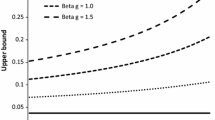Abstract
The capital asset pricing model (CAPM) is an absurd model—its assumptions and its predictions/conclusions have no basis in the real world.
Access provided by CONRICYT-eBooks. Download chapter PDF
Similar content being viewed by others
Keywords
These keywords were added by machine and not by the authors. This process is experimental and the keywords may be updated as the learning algorithm improves.
The CAPM is a very popular model. That should not stop us from forgetting about it. Simple reasoning can do the same trick.
The capital asset pricing model (CAPM) is an absurd model—its assumptions and its predictions/conclusions have no basis in the real world.
With the vast amount of information and research that has been done, it is quite clear that the CAPM does not “explain facts or events,” nor does it “describe the past, present, or future state of something.”
The use of CAPM is also a source of litigation: many professors, lawyers, etc. get hefty fees because a vast number of professionals use CAPM instead of common sense to calculate the required return to equity. Users of the CAPM make many illogical errors in valuing companies, accepting or rejecting investment projects, evaluating fund performance, pricing goods and services in regulated markets, calculating value creation, and the list goes on.
Main Predictions of the CAPM
The CAPM assumptions imply that all investors:
-
(a)
Will always combine a risk-free asset with the market portfolio
-
(b)
Will have the same portfolio of risky assets (the market portfolio)
-
(c)
Will agree on the expected return and expected variance of the market portfolio and every asset
-
(d)
Will agree on the expected MRP and beta of every asset
-
(e)
Will expect returns from their investments according to the betas
Why Is the CAPM an Absurd Model?
The CAPM is based on numerous unrealistic assumptions. It is true that “all interesting models involve unrealistic simplifications,” and while the CAPM does have some assumptions that are convenient simplifications, its other assumptions (especially the homogeneous expectations) are obviously senseless.
None of the CAPM predictions occur in the real world. And still, many professors will affirm that “the CAPM is not testable” or “it is difficult to test the validity.” CAPM is a model (a) based on senseless assumptions, and (b) none of its predictions happen in our world. Which other tests do we need to reject it?
Why Are People then Still Using the CAPM?
In 2009, I surveyed finance professors on the use of CAPM, and while many of them acknowledge that there are problems estimating two ingredients of the CAPM formula (the beta and the market risk premium), they nevertheless continue to use it for several reasons:
-
It “[h]as received a Nobel Prize in Economics.”
-
“Fortune 500 firms use the CAPM to estimate their cost of equity.”
-
“While not perfect, it is used extensively in practice.”
-
“Beta is simple and it is used in the real world.”
-
“If one does not use beta then what is there?”
-
“No substitution so far. There are no better alternatives.”
-
“There is no other satisfactory tool in finance.”
-
“Calculated betas are on the CFA exam.”
-
“Regulatory practice often requires it.”
-
“Beta allows you to defend a valuation, impress management, and come across as a finance guru.”
-
“In consulting, it is essential to fully support your estimates.”
Other professors argue that “[they] teach CAPM because it is based on the important concept of diversification and it is an easy recipe for most students.” However, think we can teach diversification without the CAPM and, more importantly, business and management (which includes investment and valuation) is about common sense, not about recipes.
Users of the CAPM have made a multitude of errors valuing companies, accepting or rejecting investment projects, evaluating fund performance, pricing goods and services in regulated markets, calculating value creation, and the list goes on.
Author information
Authors and Affiliations
Editor information
Editors and Affiliations
Rights and permissions
Copyright information
© 2017 Springer International Publishing AG
About this chapter
Cite this chapter
Fernandez, P. (2017). The Capital Asset Pricing Model. In: Frey, B., Iselin, D. (eds) Economic Ideas You Should Forget. Springer, Cham. https://doi.org/10.1007/978-3-319-47458-8_19
Download citation
DOI: https://doi.org/10.1007/978-3-319-47458-8_19
Published:
Publisher Name: Springer, Cham
Print ISBN: 978-3-319-47457-1
Online ISBN: 978-3-319-47458-8
eBook Packages: Economics and FinanceEconomics and Finance (R0)




